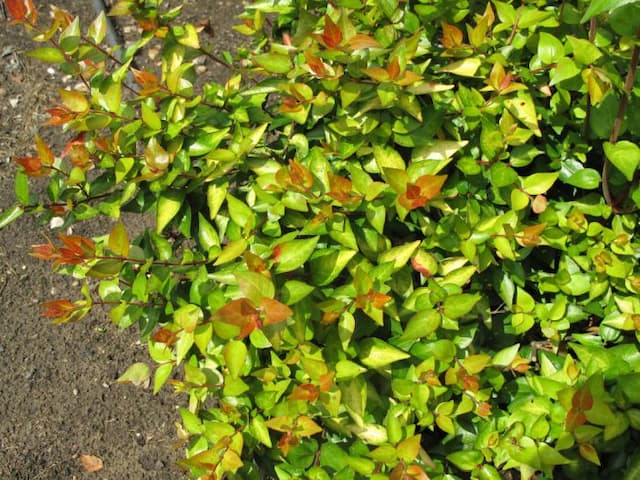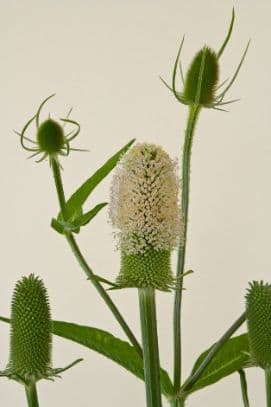Chenault coralberry Symphoricarpos × chenaultii 'Hancock'

ABOUT
The Hancock Coralberry is a decidnous, spreading shrub that is noted for its graceful arching branches and dense foliage. Its leaves are small, oval-shaped with a slightly wavy edge, and a dull green hue that lasts throughout the growing season. In the summer, tiny, bell-shaped, pink flowers bloom, which are subtle and often go unnoticed. These flowers give way to the distinctive feature of the shrub – clusters of round, berry-like fruits. These berries are initially white with a tinge of pink and gradually mature to a deep magenta or purple color in the fall, persisting through the winter months and providing visual interest when most other plants have lost their leaves. These fruits are favorites among birds, making the Hancock Coralberry a valuable plant for wildlife. The overall visual effect of the plant is a mounded, thick thicket that can serve as an excellent ground cover or as an element in a mixed shrub border.
About this plant
 Names
NamesFamily
Caprifoliaceae.
Synonyms
Hancock Coralberry, Chenault Coralberry, Hancock Snowberry.
Common names
Symphoricarpos × chenaultii 'Hancock'.
 Toxicity
ToxicityTo humans
The Snowberry, which Symphoricarpos × chenaultii 'Hancock' is a cultivar of, is considered to have some level of toxicity to humans. If ingested, the berries can cause symptoms such as vomiting, dizziness, and sedation. In severe cases, ingestion of large quantities could potentially lead to more serious effects, but such instances are relatively rare because the berries are not typically consumed in large amounts due to their unpalatable nature.
To pets
The Snowberry is also toxic to pets. If animals ingest the berries, they may experience symptoms similar to those in humans, such as vomiting, diarrhea, and drowsiness. In severe cases, pets might suffer more serious health consequences. Pet owners should prevent their animals from consuming the plant to avoid the risk of poisoning.
 Characteristics
CharacteristicsLife cycle
Perennials
Foliage type
Deciduous
Color of leaves
Green
Flower color
Pink
Height
2-5 feet (0.6-1.5 meters)
Spread
5-6 feet (1.5-1.8 meters)
Plant type
Shrub
Hardiness zones
4-7
Native area
North America
Benefits
 General Benefits
General Benefits- Low Maintenance: Hancock Coralberry is relatively easy to care for, requiring minimal upkeep once established.
- Drought Tolerant: It can survive with limited water supply, making it suitable for xeriscaping and dry gardens.
- Erosion Control: The plant's dense growth habit helps stabilize soil and prevent erosion on slopes and banks.
- Wildlife Habitat: Provides shelter and nesting sites for birds and small mammals.
- Winter Interest: Offers visual appeal during the winter months with its persistent berries and arching branches.
- Tolerant of Various Conditions: Hancock Coralberry can thrive in a range of soil types and environmental conditions.
- Attracts Pollinators: Flowers attract bees and butterflies, supporting local ecosystems.
- Compact Growth: Its smaller size makes it suitable for use in smaller gardens or as ground cover.
- Decorative Berries: Produces ornamental berries that can add color and interest to garden landscapes.
 Medical Properties
Medical PropertiesThis plant is not used for medical purposes.
 Air-purifying Qualities
Air-purifying QualitiesThis plant is not specifically known for air purifying qualities.
 Other Uses
Other Uses- Symphoricarpos × chenaultii 'Hancock', commonly known as Snowberry, can be used for creating natural dyes due to the pigments in its berries and leaves.
- Snowberry branches can be incorporated into floral arrangements for added texture and interest, especially during the winter months when their white berries stand out.
- The dense and fibrous root system of Snowberry makes it suitable for erosion control on slopes and banks, helping to stabilize the soil.
- The plant is sometimes used in the creation of habitats for beneficial insects, offering shelter and food resources for a variety of species.
- Snowberry is considered deer resistant, making it a useful plant in gardens that need to withstand foraging by local wildlife.
- The thick foliage provides nesting sites and cover for small birds, contributing to biodiversity in the garden.
- The plant can be used as a natural fencing alternative when planted in a dense row, providing privacy and a green barrier.
- Snowberry is sometimes incorporated into sensory gardens for its textural berries and leaves, which offer a unique tactile experience.
- Its relatively low height and spreading habit make Snowberry suitable for use as ground cover in large-scale landscaping projects.
- During festive seasons, Snowberry can be used as a decorative plant indoors because of its appealing winter berries that align with holiday themes.
Interesting Facts
 Feng Shui
Feng ShuiThe Snowberry is not used in Feng Shui practice.
 Zodiac Sign Compitability
Zodiac Sign CompitabilityThe Snowberry is not used in astrology practice.
 Plant Symbolism
Plant Symbolism- Protection: Symphoricarpos species, commonly known as Snowberry, have been thought to symbolize protection due to their hardy nature and the folklore of some native tribes using the branches to make protective wreaths.
- Innocence: The delicate and soft appearance of Snowberry's white berries is sometimes associated with purity and innocence.
- Hope: As Snowberries remain on the branches into winter, they can symbolize hope in hardship, enduring through tough times.
 Water
WaterSnowberry 'Hancock' should be watered thoroughly to saturate the root zone, then allow the soil to dry slightly between waterings. Watering frequency depends on weather conditions but generally, once a week is sufficient. During hot, dry periods, it may require watering two to three times per week. When watering, apply approximately one to two gallons of water for each plant to ensure deep hydration of the roots, but adjust this amount based on plant size and soil conditions.
 Light
LightSnowberry 'Hancock' thrives best in full sun to partial shade. It should be planted in a spot where it can receive at least four to six hours of sunlight daily. While it tolerates some shade, too little light may reduce flowering and berry production.
 Temperature
TemperatureSnowberry 'Hancock' is adaptable to a range of temperatures and can survive minimum temperatures down to -40°F. It thrives in temperatures between 60°F and 75°F but is quite hardy and can withstand the heat up to 95°F.
 Pruning
PruningPruning Snowberry 'Hancock' helps to maintain its shape and encourages new growth for better flowering and berry production. Prune in late winter or early spring before new growth starts. Cut back any old, damaged, or overgrown branches and thin out the plant to allow light and air circulation. Pruning can be done annually or as needed when the plant becomes too dense.
 Cleaning
CleaningNot needed
 Soil
SoilSnowberry 'Hancock' thrives best in well-drained, loamy soil with a pH of 6.0 to 7.5. A soil mix containing equal parts of garden soil, sand, and compost will provide the right texture and nutrients for healthy growth.
 Repotting
RepottingSnowberry 'Hancock' typically doesn't need frequent repotting and can be done every 2-3 years. It's best to repot during the dormant season.
 Humidity & Misting
Humidity & MistingSnowberry 'Hancock' is tolerant of a wide range of humidity levels and generally does well in average outdoor humidity conditions without specific requirements.
 Suitable locations
Suitable locationsIndoor
Provide bright light, occasional watering.
Outdoor
Plant in well-draining soil, full sun to partial shade.
Hardiness zone
4-7 USDA
 Life cycle
Life cycleThe Snowberry 'Hancock', starting as a seed, germinates in the spring under suitable conditions of moisture and temperature. Seedlings establish a root system before sending up shoots that will develop into mature stems. The shrub grows and matures, typically reaching its full size of 2 to 5 feet tall and wide, with a rounded, sprawling habit. During the summer months, it produces small, bell-shaped, pink flowers which are both attractive to pollinators and give way to the plant's characteristic white berries in late summer to fall. These berries often persist into winter, providing food for birds, after which they will decay or be consumed, completing the reproductive cycle. Throughout its life, which can last for several years, the plant will go through periods of dormancy during cold winters, resuming growth in the spring.
 Propogation
PropogationPropogation time
Spring to Summer
Propogation: The Snowberry, specifically the Symphoricarpos × chenaultii 'Hancock', is commonly propagated through semi-hardwood cuttings. This popular method usually takes place during the summer months when the plant's growth has begun to harden but is not yet fully mature. To propagate by cuttings, a 4 to 6-inch (approximately 10 to 15 cm) piece is taken from the current year's growth, ensuring that a few leaves remain. The cut end of the stem is often treated with rooting hormone to facilitate root development and then planted in a mixture of peat and perlite or a similar rooting medium. The cuttings should be kept moist and under conditions of high humidity until they have rooted, which typically takes a few weeks.








